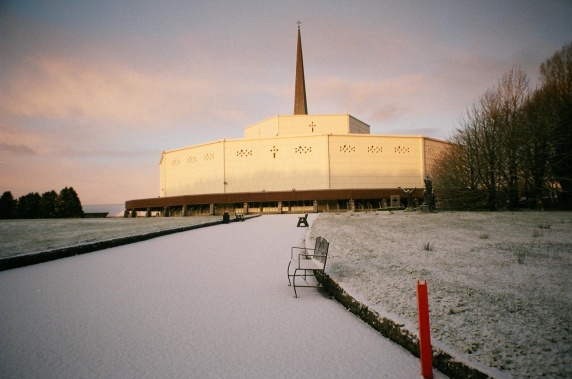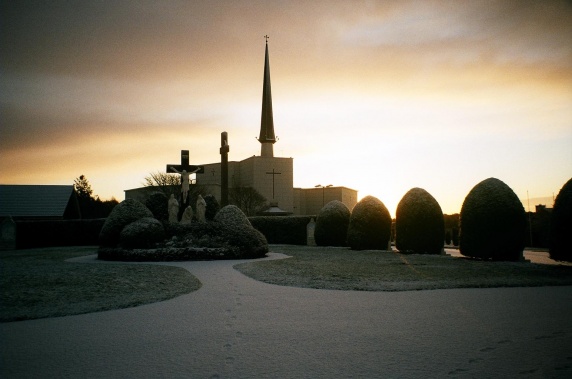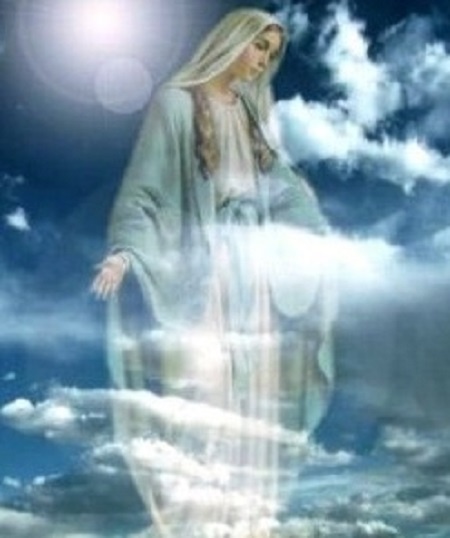Knock:Apparition/Significance.


Knock: Apparition and The Apocalypse.
We can look at the ways in which the Apparition at Knock corresponds with the Apocalypse of St John the Apostle/the Divine. St John is also known as St John the Evangelist.
St John is the author the fourth Gospel and the author of three Epistles in the New Testament. And he is the author of The Apocalypse, the last Book of The New Testament.
Note that the Catholic Church has always held St John the Apostle to be the author of The Apocalypse. (Apocalypse is a Greek word meaning “revelation.”) St John received the revelation whilst he was on the island of Patmos, and wrote it down.
A figure identified as being St. John is very prominent in the apparition at Knock.
The setting for the apparition was the village of Knock, Co. Mayo, in the rural west of Ireland. Ireland, poor, but beautiful, and rich in spiritual graces. The great famine had been a recent trauma, and poverty was prominent for many. And indeed, many at that time in Mayo would have taken great comfort in their Catholic Faith, and in these words of Our Lord: “For what does it profit a man, if he gain the whole world, but suffer the loss of his own soul? Or what will a man give in exchange for his soul?[Mk 8:36-37, Mt 16:26.]
The apparition brought no spoken words but the strong visual imagery provides many thought provoking things for us.
What happened?
During the evening of August 21st, 1879, the church housekeeper, who was on her way to visit a friend, walked past the church. As she did so, she became aware of luminous figures and an altar at the gable end of the church. Two other witnesses saw the same; initially they thought that what they were seeing were new statues that had recently been ordered by the parish priest, Fr Cavanagh. He, however, did not witness the apparition.
More villagers gathered and, as they each approached the church, they realized that the figures were moving. They saw that they were wearing beautiful white garments, and that they were positioned in front of the church wall, standing in a glorious light. A number of villagers prayed the Rosary. The apparition lasted for about two hours. It was raining heavily, but there was no rain near the apparition itself.
The villagers recognized one figure as being of the Blessed Virgin Mary and, to the right of Her, they saw a figure who they understood to be of St Joseph, who was inclining his head, as in an act of reverence. To the left of the figure of the Blessed Virgin, stood a figure wearing a mitre, he held a book opened in his hand; some of the villagers recognized the figure, from how he is presented in statues, to be that of St John the Apostle/the Divine. He was holding a book opened in one hand and with the other arm and hand raised and opened; as though exclaiming. There was comment that he was very handsome.
The figure of the Blessed Virgin wore a crown and stood with Her hands raised in an attitude of prayer. She was gazing towards heaven, Her lips were moving in prayer. And on the altar was seen a large Cross, and in front, a young lamb. One witness saw angels with wings fluttering above the altar. The figure of the Lamb was standing. Two witnesses also described what they saw concerning the altar itself. One witness stating:
_______
“I saw an altar there and figures representing
saints and angels traced or carved on the
lower part of it. “ *
Another witness said of St John:
“...the index finger and the middle finger of the
right hand raised, as if he was speaking, and
impressing some point forcibly on an audience..” *
_______
There is also the focus on the Catholic Mass. The whole setting at Knock brings to mind the Mass; especially the altar: A witness stated:
_______
“The altar appeared to be like altars in use in
the Catholic Church, large and full sized.” *
_______
And with the figure of St John holding a Book opened and at the gospel side of the altar there is also a focus on the gospels, and which St John would of course always want to impress upon an audience. One witness said that St John was holding: “the gospels or Mass book.” and another witness that St John was holding “a book of the gospels ”
Church approval of the Apparition, and its significance.
There were fifteen main/official witnesses.* The Church investigations concluded with approval of the apparition. As did a later investigation in 1936. What about its meaning and significance? This is, of course, crucial.
There was much in the apparition and these were also highly significant times; the Church needed to understand that we had entered the last times of the world as we know it. St John has a great focus on the last times in The Apocalypse.
Knock and The Apocalypse.
There is, indeed, the inescapable, and very apparent aspect of the apparition; that the setting at Knock corresponds very precisely with significant parts of the Apocalypse of St John.
The Apocalypse concerns the build-up to the Lord's Second Coming in Judgement. St John appearing at this time must, therefore, be given attention in the context of the very last times of the world and the preparation for the Lord.
And so what does Knock tell us in this context? Well, it tells us very many things indeed !
The figure of St John wearing a Bishop's mitre accords with the beginning of the Apocalypse where he sends the Apocalypse (as a Bishop would send) to “the angel” (Bishop) of each of the seven churches of Asia Minor (Apocalypse ch 1-3) and specifically (Apocalypse ch 1:10-11.)
Traditional Catholic commentary on these early verses of the Apocalypse (for example, this from The Holy Family Bible 1950)** is as follows:
_______
“CHAP.2.VER.1, Angel, the guardian of the church or The Church itself; or, and this is the common view, the bishop of the church. If St John addresses the bishops, He regards them as the incarnation of their respective Churches.” * * *
_______
And so in the whole opening setting of The Apocalypse, St. John is very associated with Bishops. Firstly, in sending, as though a Bishop sending to his churches. And secondly, in sending to “the angel” (interpreted as being to the Bishops of those churches.)
White robes are emphasized strongly in the Apocalypse (3:4-5) (3:18)(4:4) (6:11) (7:9) (7:14) (7:13-17) also (7:3) (9:4) (22:14.) White robes are shown prominently at Knock.
At Knock there is the figure of The Lamb:
Our Lord as “The lamb” is very prevalent throughout the Apocalypse.
The figure of a Lamb standing accords with Apoc. 5:6.
As to the two witness accounts as to what they saw on the lower part of the altar, St John in the Apocalypse writes of the Lamb:
______
And when he opened the fifth seal, I saw under
the altar the souls of those who had been slain
for the word of God, and for the witness that
they bore. (Apoc 6:9)
Here are three further quotes from the Apocalypse itself:
Our Lord:
“..He who overcomes shall be arrayed in
white garments, and I will not blot his
name out of the book of life, but I will
confess his name before my Father,
and before his angels.” (Apoc. 3:5)
St John:
. I saw a great multitude which no man
could number, out of all nations and
tribes and peoples and tongues,
standing before the throne and
before the lamb, clothed in white robes....(Apoc. 7:9)
And one of the elders spoke and said
to me, “these who are clothed in white
robes, who are they? And whence have
they come?” And I said to him, “My Lord,
thou knowest,” And he said to me, “These
are they who have come out of the great
tribulation, and have washed their robes
and made them white in the blood of the
lamb. Therefore they are before the throne
of God, and serve him day and night in his
temple, and he who sits upon the throne
will dwell with them. They shall neither
hunger nor thirst any more, neither shall
the sun strike them nor any heat. For the
lamb who is in the midst of the throne will
shepherd them, and will guide them in the
fountains and waters of life, and God will
wipe away every tear from their eyes.” (Apoc. 7:13-17)
______
And the apparition taking place at "The church of St. John the Baptist;" the parish church at Knock. And with this inscription placed on the west outer wall of the church when it was built, by the parish priest at the time, Fr O'Grady:
_____
"Matt.11 Chapt. My house shall be called the house
of prayer to all nations." Ps.117. This is the gate of
the Lord: the just shall enter it."
_____
St John the Baptist brings a focus on preparation for the Lord; “make ready the way of the Lord, make straight his paths. (Mt 3:3) (Mk 1:3) (Lk 3:4) (Jn 1:23.)
The Apocalypse has, as its main great focus, Our Lord's glorious Second Coming and the times leading up to this great event. St John is the author of The Apocalypse!
The timing of Knock and the Apocalypse.
Many things were happening in Ireland at that time, as indeed they were elsewhere, but none to compare with the significance of the Divine timetable. And Church and mankind needed urgently to heed the times; the last times of the world, that we are now in; and in very difficult circumstances.
* Testimonies of the witness of the apparition can be seen on the Knock shrine website (History page.)
** The Holy Family Bible: The Holy Bible: Douay-Challoner Text: New Testament and Psalms in the Confraternity Text. Approbation, Cardinal Stritch (Imprimatur) 1950. Virtue & Company Ltd. 1956.
*** Holy Family Bible. New Testament section. ibid p241



A Short Guide to Understanding The Apocalypse; And These Very Last days Of The World That We Are Within. Shown in full here. It includes an...
This Era (the two eras.) We have, in effect, two final eras. The era of Preparation For The Lord. And the era that the apostate angels...
Pro-Life: Imperative. The concern is for lives And for souls. All humans should do what they can to steer well clear of the...
The following was written for the build-up to the Referendum in Ireland in October 2018: Why Blasphemy Law is never outdated. All...

O Mary our Mother, how you would have us prepare in the right way for your Son.
Help us to try.






